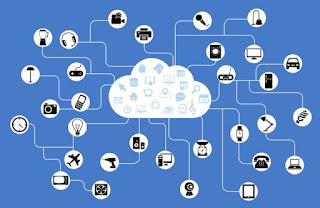What is machine-to-machine communication?
Machine-to-Machine communication is one of the important building blocks in IoT. It is a type of communication where the communication takes place without the interaction of the human being. The machines are connected through a network and they are sending signal among them and according to the signal, the actuation is done.
This types of connections are adopted by the industries where the huge amount of work is required in short time. Machine-to-Machine communication is designed for cross-platform integration.
source-nptel
This types of connections are adopted by the industries where the huge amount of work is required in short time. Machine-to-Machine communication is designed for cross-platform integration.
source-IoT training institute Bangalore
There are many examples of machine-to-machine connection like -- Environmental monitoring
- Automation of building
- Agriculture
- Home networks
- Security purpose
source-nptel
Explanation of the picture:
- There are two running cars on the road and they have them different sensors. For some reason, the accident happened and two cars are colloid.
- Signals are sent to the remote servers.
- From the remote server, the signals (1) may transfer to the hospital directly. The hospital authority will come to know about the accident and they can get time to prepare. (2) may transfer to the doctor so that the doctors will be available for the emergency case. (3) may transfer to the paramedics or to the ambulance.
This communication consumes less power, low cost, a large number of devices are connected, small traffic is generated per machine, human interaction is not required.
M-to-M Nodes:
- Low-end sensor node
- Mid-end sensor node
- High-end sensor node
Low-end Sensor Node:
- Low-end sensor nodes are cheap.
- The capability of work is also very low.
- It has some general features like data aggregation, auto configuration, energy saving etc.
- Typical application includes environment monitoring application.
- Resource constrained and IP not supported.
Mid-end Sensor Node:
- Mid-end sensor nodes are expensive than the low-end sensor node.
- Typical application includes industrial automation, home networks etc.
- Some additional features are added with the features of low-end sensor like localization, quality of service and intelligence.
- IP is supported.
- Nodes may have mobility.
High-end Sensor Nodes:
- Low-density deployment.
- It is essential to have the mobility to the nodes.
- Able to handle multimedia data with quality of service support.
- Used in smartphones.
Machine-to-Machine area network:
source-nptel
Explanation of the above picture:
- There is a device provider who provides devices.
- There is a gateway through that gateway data can be sent to the internet.
- When data is sent to the internet an IP address is allocated for that.
- There is a platform provider who provides platforms to handle the data and the services. Device management, user management, data analytics and user access management are done.
- On the right hand, there are the users who use the web applications.
Machine-to-Machine Features:
- Low cost.
- Low complexity.
- Energy efficient.
- Scalable.
- Traffics are managed.
- Applications include real-time application,data centric application,emergency application.






Comments
Post a Comment